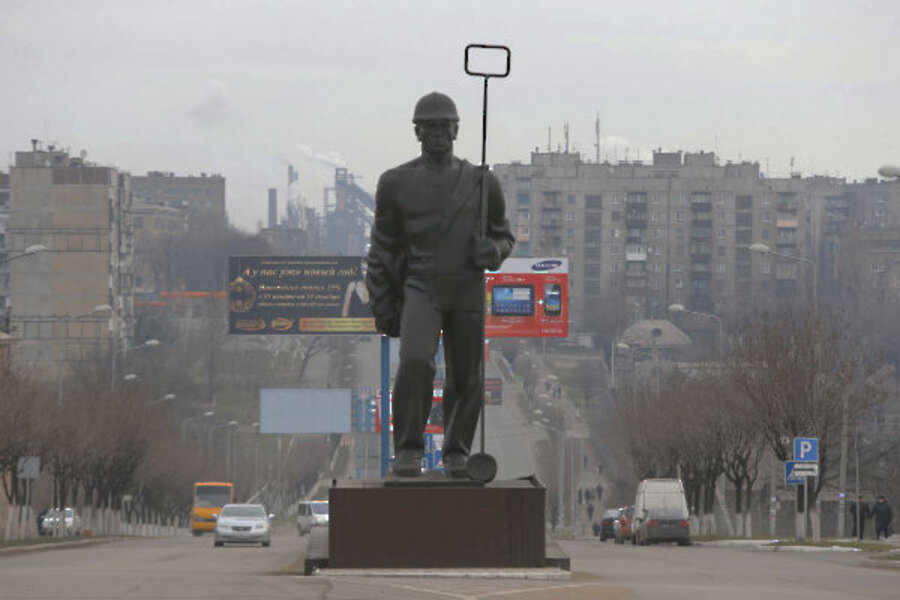Even if Ukraine averts political meltdown, economic obstacles remain
Loading...
As Ukraine's parliament mulls the country's political future today in emergency session, it’s important to remember that the divide between the government and protesters is not only about values. A vast array of destabilizing factors that had helped to precipitate the turmoil will not be solved away by a political resolution when one arrives.
Any government emerging from the current crisis will have to grapple with pervasive economic challenges that helped spark the fires of protest in the first place. Even if Prime Minister Mykola Azarov's offer to resign and today's repeal of controversial anti-demonstration laws assuage street protesters, a few key potholes remain on the road to Ukraine's stability.
A tottering economy
Ukraine is the only post-Soviet country that has yet to regain its footing. Its GDP per capita remains stuck below its 1989 level, which, the World Bank noted in January 2014, is “a mere 10 percent of the European Union average after twenty years of transition.”
While the country does have a small but robust middle class – amply represented among the demonstrators – incomes for its 46 million people have grown slower for the past two decades than those in Belarus, a country ruled by a full-out authoritarian regime. Poland's income per capita started at a similar level 25 years ago, but have risen to almost four times that of Ukraine since.
Ukraine’s economy was clobbered in the 2009 crisis, which eviscerated global demand for steel, its primary export. Exports shrank by almost one-half, and GDP plummeted by almost 15 percent. Since then the country has been in and out of recession. Even before the recent protests erupted the economy had been slipping: GDP contracted in the first two quarters of 2013.
A backlog of economic mismanagement
The government’s failure to carry out long-overdue economic reforms made matters worse. Ukraine has been the target of a series of scathing assessments from the International Monetary Fund and the World Bank, most recently in December 2013, when the IMF noted flatly that the Yanukovych government had “stopped implementing the agreed policies.”
The government has failed to realign its fiscal and monetary policies in a way that would revive growth, the IMF said. Limited exchange-rate flexibility – the national currency is pegged to the dollar – further hobbled exports and worsened the trade deficit. An inefficient banking system stifled access to finance. And all the while, the government kept spending generously on “large pension and wage increases, generous energy subsidies, and soccer cup spending [as co-host of the 2012 UEFA European Championships].”
As a result, the government ran out of money. By early December, it faced $60 billion in maturing debts and a scant $20 billion in national reserves, according to Reuters – with state coffers holding less than three months' worth of imports, the accepted international minimum.
The Russian bailout – buying $15 billion worth of Ukrainian bonds and slashing gas prices by a third – saved Yanukovych from default at the cost of putting Ukraine on Moscow’s “drip feed.”
Endemic corruption
The protesters’ universal chant – “thieves out!” – reflects widespread exasperation with Ukraine's climate of corruption and graft at all levels. The exasperation is understandable: Transparency International ranks Ukraine 144th out of 177 countries in terms of perceptions of corruption, worse than any other country in Europe. The watchdog group noted that Ukraine’s ranking has fallen due to “protectionism and the fusion of political and business interests.”
The problem reaches far beyond the president's inner circle, says the December 2014 World Bank report. Rather, corruption “is rooted in the country’s political culture,” built upon an old model that fuses political influence and economic power.
East-west divide
Ukraine's east-west political fault line is based on linguistic and cultural factors. But an equally powerful insight into its geographical divide comes from its foreign-trade balance sheets.
Put simply, Ukraine’s west is dependent on its east. The western regions remain dominated by agriculture, and what products Ukraine does export in large quantities – including steel, iron, and coal – come from the old industrial heartland in the east, in regions such as Donetsk and Luhansk. European demand for these products has been climbing, but production remains predominantly tied to Russian demand.
However inefficient the factories and mines inherited from the Soviet system, their thousands of workers regard their bread-winning role for the country with great pride. As The New York Times reported in the early days of the protests, they had one common message for demonstrators in Kiev: “Get back to work.”








